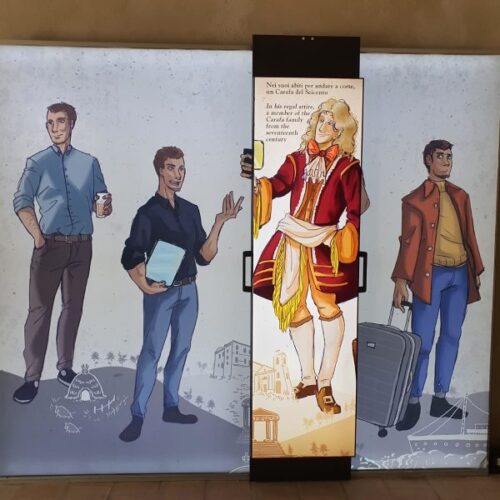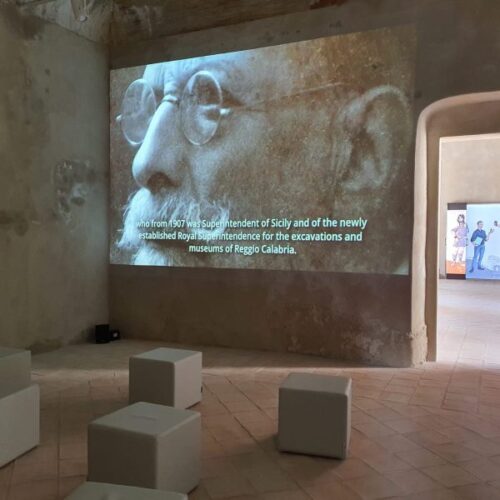Musmir - Immersive Multimedia Museum in Roccella
Civita
- Civita
OUR SERVICES
- Exhibition Design
- Content production
- Graphic Design
- Multimedia set-up
- Digital Design
- Serious game / Gamification
A journey through spaces, places and technologies to narrate and excite
An immersive and fascinating tour itinerary dedicated to the discovery of the Rocella Jonica Castle and the Carafa family that is divided into two moments. A chronological itinerary that narrates the history of the castle from the pre-Hellenic period to the 20th century and contemporary times through immersive technologies such as virtual reality stations, sliders, lightboxes, touch screens and gamification elements.
An itinerary that starts from the family genealogy and two innovative exhibits to engage the visitor in the discovery of the environments and immersively recreate the authentic places and atmospheres. The project combines technology and storytelling to make the visiting experience exciting and encourage not only the understanding of information, but also the identification of the visitor through storytelling, using emotional engagement to convey the content.


The chronological route
In the first room of the chronological route, immediately following the ticket office, a pre-Hellenic Hut has been recreated, crossing the threshold of which metallic noises and a back-projected scenery allows the visitor to enter the remotest past. The visitor is inside an immersive station, enclosed on three sides and at the top. The side walls and roof of the hut are made of lightboxes, backlit graphic structures, while the textured scenic floor reproduces the earthen feel typical of dwellings of the time.
Inside the Castle’s largest room, the one dedicated to the Classical Age, there are four different multimedia stations:
Slider with Historical Timelin – This station consists of a backlit lightbox and a track structure on which a vertical monitor slides. Visitors can slide the monitor across the graphed canvas and, depending on where they are, see a thematic overlay between the present and the past, with four different historical phases related to the area.
VR station – The landing of the colonists, two stations where visitors can sit to enjoy the VR video through visors. The station is placed in front of the window with a panoramic view of the coastline that saw the landing of the colonists: this creates a visual connection between the real world and virtual reality, in which the visitor finds himself in the middle of the sea, on a Greek boat that travels from the motherland to the land that over the centuries will be known as Magna Graecia.
Touch Station – Discover and Learn, a table that houses a touch monitor and a card reader equipped with TAG NFC, a station allows the visitor full interaction, to discover and view insights into significant places of classical archaeology on the Ionian coast of Calabria.
Touch Station – The Settlers, a Map of the Mediterranean, viewable via a Touch Monitor, allows the visitor to view in-depth fact sheets, images and videos related to the routes of the settlers in the Mediterranean and the products that were traded and exchanged between different cities.
Contents related to the Roman era are presented in the dedicated room through a wall projection, with video and audio narration (with voiceover entrusted narration by Luca Ward). The video playback, triggered by the visitor’s passage thanks to sensors, makes the user an activator of the experience as he or she passes through, increasing the sense of awe.
Next, the room will be dedicated to telling the story of the Roccella Jonica castle’s transformations over time. What attracts attention is the three-dimensional model depicting the castle placed on a specially made MDF base on which four touch sensors are positioned: by touching it, in-depth wall projections, accompanied by immersive and evocative audio, are initiated, discussing the castle’s history, phases and changes in the structure.
The twentieth century and contemporary era, represented by the jazz theme, is explored in depth in a room with two dedicated stations:
- The Locomotive
Upon entering the room, thanks to the presence of a backlit lightbox with a graphic reproduction of a locomotive, content related to the themes of industrialization and emigration are presented to visitors. A monitor is inserted at the train conductor’s window, on which a video is played in which the train conductor speaks in the first person who, after a short story, introduces dialogue with other characters who are at the other windows of the locomotive (at the same number of monitors). Thanks to the presence of a sensor, the visitor is surprisingly greeted by the dialogue that is triggered as he or she passes by. - Game Jazz station
The station is characterized by the possibility of interacting with music through a gaming solution. Through a graphic animation, created through the use of two monitors, a score appears on the first monitor in which it is possible to play a portion of a piece of jazz music, thanks to the directions that appear on the other. At the end of the game, visitors can find out their placement in the daily ranking.
The exhibit was technically realized through the use of two Samsung 55” 4K monitors (one of which is touch) embedded in an MDF structure that reproduces the shape of a wall piano. Visitors can, thus, test their musical skills in a real rhythm game.
The Carafa Apartments
Genealogical Tree Hall
The room features two exhibits that serve to introduce visitors to the Carafa Family and some of its best-known representatives:
- On a wall structure, with backlit graphic print, a family tree has been recreated where, among the various family members, there are five animated paintings. In the structure, in fact, five monitors (13” SAMSUNG Full HD monitors) offer a series of looped videos, made by actors in period costumes, who make small movements, creating a visual suggestion in which the characters present themselves to the eyes of visitors.
- On another wall, there is a magic mirror where visitors can activate Augmented Reality content that leads them to interact with the environment and period accessories and jewelry. The visitor sees himself reflected on a monitor (43″ Samsung 4K monitor) and through a tablet (iPad Pro 12.9″) can select some accessories to be worn virtually among those typical of the Neapolitan courts of the six-eighteenth century. After choosing the preferred accessory, the visitor also slews a background – for example, the reception hall or private rooms. Once the selection phase is over, a photo can be taken and sent to one’s e-mail. In this way, the visitor can keep a visual and personal memento of the museum experience to share on social profiles and become a content creator himself.
Siege Room
The visitor finds himself initially in the dark. Upon entering, the presence sensor activates an immersive projection on three walls with a CGI video, in which the re-enactment of Dragut’s siege and the clash between the people of Roccella and the Saracens is presented. The visitor is projected into a high-impact video and audio narrative, thanks to the timely use of technology: he is at the center of an immersive environment designed with the aim of exciting and, at the same time, disseminating historical content.
Portrait Room
The hall houses a talking picture gallery in which – via language selection buttons – four characters converse with each other, coming to life in front of the visitor. On four walls of the room, at the niches, four monitors (55” Samsung 4K monitors) are placed within a lightbox structure graphed to create the visual effect of a framed picture.
Prince’s Hall
A scenic backdrop with prints reproducing period furnishings will allow the environment of a Neapolitan drawing room to be reconstructed. Thanks to the sensor system, a projection of Prince Vincenzo Maria Carafa appears before visitors and narrates his story. The visitor is in front of a full figure: interaction with the character is, therefore, engaging and extremely realistic.
